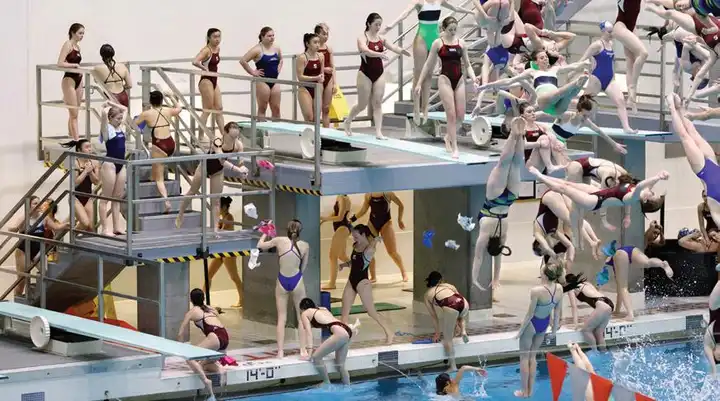
3 minute read
THESE MESMERIZING IMAGES OF ATHLETES REINVENT SPORTS PHOTOGRAPHY

BY JESUS DIAZ
Advertisement
Photographer Pelle Cass is pioneering a fascinating way of capturing sports on camera. Instead of focusing on particular moments, he tries to catch everything that happens on one particular arena and merge it into one single image. The result is akin to the frescos that decorate baroque palaces and church ceilings–visual choreography involving hundreds of characters frozen in one single graceful moment.
It’s an arduous process that requires infinite patience and a keen eye, both to take the photos and especially to post-process them. Speaking with Cass over email, he told me that most of these composite pictures require at least a thousand individual photos taken over the course of about one hour. He then has to go through all those photos and select the ones that are interesting and work well with the overall final composition, placing them in 400 to 500 layers in Photoshop. It’s a process that usually takes him 40 to 60 hours.
Since he started this series last fall, Cass says, he checks the athletics calendars of the local colleges with big sports programs around his Brookline, Massachusetts, studio–whether it’s Harvard, Boston University, Boston College, Northeastern, or MIT. “I don’t need permission or a press pass or anything,” he says. “Sometimes I have to buy a five dollar ticket or maybe buy a brownie at the fundraising table. But I just walk in and get to work.” This is important, as in a professional sports arena, he would have to use specific locations to shoot–and compete with other photographers. “It takes me a while to consider the angles and figure out where I want to set up,” he says, picking “high, distant vantage points if I can find them.” He also says that he likes “photographing more obscure sports since big spectacles are covered […] I think sports are paid too much attention, sometimes at the expense, in college sports, of education.”
Before settling down to work, Cass does a couple of test shots at different locations–important, since he needs an hour of activity to complete one image. Once he picks a sport, he starts shooting immediately, careful not to touch the tripod under any circumstances. “It’s boring and fascinating at the same time,” he confesses, because he can’t really watch the competition. Instead, he has to focus on observing where the athletes tend to move, and where they rarely go on a court or in a venue (not to mention pressing the shutter when they do something interesting).
He never moves the figures he captures. “I don’t change a pixel,” Cass says, “I simply decide what stays and what goes. That way, I can say that I’m recording something real and true, even if the eye never sees it that way.”
Back in the studio, it’s time to select the images that go into the final composition. “It takes a long time to get to know what’s in a thousand images, so I just plunge in and start trying things. I often start with figures that are the most expressive or unusual and build from there,” he explains. “It’s a little like a slow-motion game of Tetris,” one in which he tries to fit people in a space so they fit with each other. Sometimes he trashes everything and starts again. Other times, he ends with two unique versions of the same session.
Cass particularly loves the idea of capturing photos in which the stands are pretty much empty, reversing the typical sport photo in which a massive public watches just a few athletes. In his photos, the crowd is in the field, with hundreds of players dancing with each other across time and space
He’s far from finished with this series. “I’m in the process of trying to photograph as many sports as I can,” Cass says, “ticking off new locations and new sports from my list is a priority.” You can follow his fascinating work on Instagram.










